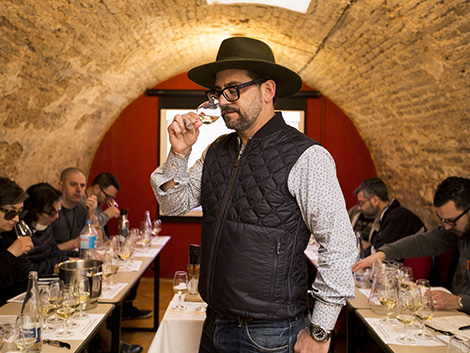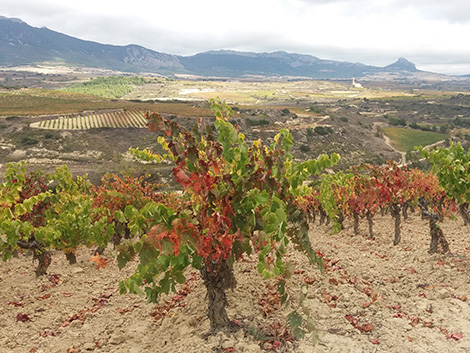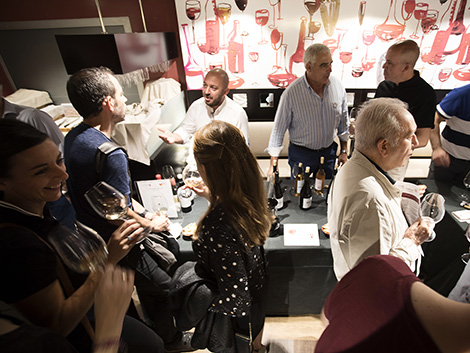
The answer was completely unexpected: a distributor from New York placed Manchuela at the top of Spain’s most exciting wine regions! But Thomas Byrnes, founder of T Edward Wines (14% of Spanish wines in their portfolio and headquarters in Tribeca) finds many analogies between Bobal and Nebbiolo. He came to this conclusion after tasting the wines of Juan Antonio Ponce. “Despite his youth, Ponce is a talented, passionate man who will do big things,” he said confidently.
Byrnes was one of 100 US wine professionals who took part in Running of the Scales, an event in Sanlúcar de Barrameda (Cádiz) organized by North Carolina importer De Maison Selections last April. In addition to several master classes on Sherry and a dinner by the beach, there was a full day to taste and chat with the Spanish and French producers in the company’s portfolio.
De Maison Selections has built a solid reputation as an importer of Spanish wines in the US selling family, terroir-driven wines made by the likes of Do Ferreiro, Emilio Rojo, Viña Meín, Cía de Vinos Telmo Rodríguez, Ostatu, Viña Sastre, Maestro Sierra, La Cigarrera, Txakoli producers Ameztoi or Gorrondona, or La Zorra in Sierra de Salamanca.
Founder André Tamers is a world citizen with a gift for languages. Son of an American father and French mother, he was born in Texas and spent his early years in Venezuela. His first languages were Spanish and French and he did not learn English until he was 13. Tamers studied French literature at the University of Florida and worked as a waiter and wine buyer before moving to New York in the 1980s where he met a young Álvaro Palacios and was able to taste Pesquera for the first time.
The modern era
At the beginning of the 1990s Tamers embarked on a new challenge and moved with his wife to Barcelona with the intention of studying and devoting himself to painting. But while working as a waiter in a restaurant at the foot of the Tibidabo mountain, he came across a bottle of Remelluri which made him realise that “the world of wine was going to change completely in Spain”.
During his time in Barcelona, Tamers was very fond of Avinyó, a Cava made by a family producer that traced its growing tradition to the 16th century but had limited commercial activity. Upon his return to the US, Tamers settled down in North Carolina and tried to sell a few bottles of this Cava. With a little help from Tom Byrnes, Avinyó was listed in Gramercy Tavern, a top dining destination in New York, and the wine ended up in The Wall Street Journal’s Top 10 Sparkling list compiled by wine columnist Lettie Teague. Despite being little known in Spain, Avinyó exports 70% of its production and is still imported to the US by De Maison Selections.
With his importing business well underway, Tamers travelled to Vinexpo wine fair in Bordeaux “at a time when Spain still sold lots of oxidated wine” and Priorat was opening up to the world. “Spanish wine writer José Peñín said it was going to be an incredible region”, he recalls. Tamers regained contact with the Palacios family and was able to sell some of their Riojas; he also tried unsuccessfully to explore other regions that still lagged behind like Arlanza in Castilla y León. “Spain's main weakness at the time was that the wines were at risk of becoming caricatures of their respective regions. It was important to show that Spain wasn't all about olés, bulls and cheap wines.”
Txakoli, Galicia, Madrid and Rioja Gran Reserva
For Tamers, Txakoli marked a turning point in the perception of Spain as a wine-producing country “thanks to its low alcohol content”. The first Txakoli producer in his portfolio was Ameztoi, a family business based in Getaria (Gipuzkoa, Basque Country) after Tamers drank their wine in Ganbara, a restaurant in San Sebastián. Tamers says that Ameztoi hit the mark with their exciting, highly demanded Txakoli rosé which is now sold by allocation.
According to the American importer, easy-to-drink wines such as as Txakoli help Spain to offer not one but many different choices in terms of its wine potential. Even today, Tamers continues to get surprised by the success of this Basque speciality: “My clients get mad because we run out of wine.”
As for which regions or styles have a bright future in the US market, André Tamers highlights three: “Galicia, which is really exciting; Madrid [Gredos] has achieved major exposure thanks to Comando G and, although a quiet trend, there is always a market for classic Rioja. I recently met up with the team of a highly avant-garde restaurant with one Michelin star because they wanted to have a Gran Reserva on their wine list.”
Jerez: the future lies in the vineyards
Although with a less rosy outlook, Sherry is an important focus for De Maison Selections. “Sales are stagnant,” says Tamers, “but the market exists, we are passionate about the wines and continue to sell them.” In his opinion, part of the problem lies in the fact that Sherry remains “virtually unknown” and is missing in the wine lists of many two and three Michelin-starred restaurants.
For Tamers, Sherry is a wine region with many different identities beyond finos and 18% vol. wines. He is particularly interested in the new unfortified, flor-aged wines and is going to add a new producer to his portfolio, someone who is first and foremost a grape grower. “The future of Jerez lies in a return to the vineyards,” André points out.
Tamers is convinced that the aromas and flavours of natural wines may open the doors for Sherry as it may be easier to appreciate the yeasty notes of a 12% abv. Palomino. “The future will be brighter if wines are less manipulated; there has been an excess of manipulation in this region,” he adds.
Distinctive, real wines
Wine buyers and sommeliers who purchase wines from De Maison Selections tend to focus primarily on small producers who farm their vineyards organically and make authentic wines. For them, artisan is not just a buzzword; it must also be felt in the glass. One buyer remarked in Sanlúcar that “fewer and fewer people are buying $6 Albariño in the United States because it is not real.” The goal now is getting “entry-level wines that provide original, distinctive nuances.”
Angélica Intriago from Despaña Brand Foods, a New York-based importer and retailer of Spanish products with a wine shop in Manhattan, points out that American consumers are open to many things. “We want the people coming into our store to learn and explore trends.” Her portfolio features many young Spanish producers as well as natural wines, orange wines or any other made in Spain style which they believe may surprise their customers.
According to Tamers, “with all its good and bad things, the US is an influential, multicultural country. Its rich cuisine is the result of many different influences: Japan, China, Thailand… and the rest of the world. Wine has to keep up with the times and today the trend is fresh wines with acidity and a sense of place plus sustainable farming practices with an eye on the future and on the preservation of the vine heritage.”
Trump’s annoying tariffs
To what extent will the new 25% tariffs imposed by Donald Trump slow down the evolution of the sort of Spanish wines sold by De Maison Selections?
Tamers says this is a serious issue which will have an impact, even if its consequences are difficult to predict. De Maison Selections will keep prices unchanged until the end of the year, but they are getting ready to cope with the new reality from 2020 onwards. The US-based importer thinks that new tariffs are likely to damage the trend towards lower alcohol wines since the higher taxes apply to bottled wines under 14% abv. which will become more expensive.
Some factors that may alleviate the situation are the current strength of the dollar, the fact that many wines already reach a base of wealthy consumers and the fact that many consumers are still unaware of this measure —the picture is rather complex in the US with other worrying concerns like the turbulent times the car industry is going through.
“Spanish wine is a growing category in the US; it is still far from reaching its peak and has gained certain recognition. Many wines still compete in terms of value for money, but I don't think people will stop buying Spanish wine, neither Burgundy,” notes Tamers.

Amaya Cervera
A wine journalist with almost 30 years' experience, she is the founder of the award-winning Spanish Wine Lover website. In 2023, she won the National Gastronomy Award for Gastronomic Communication
NEWSLETTER
Join our community of Spanish wine lovers






